“A company of fine riflemen was accordingly enlisted, and embodied at the expense and risque of their private fortunes, to act in defence of the common cause on the sea-shore."[001] But before the volunteers could be despatched over the mountains it became apparent that their services would be needed at home for the defence of the frontier against the Indians.
Through the trader Isaac Thomas it soon became known to the settlers that Cameron, the British agent, was among the Cherokees, endeavoring to incite them to hostilities against the Americans. At first the Indians resisted the enticements—the hopes of spoil and plunder and the recovery of their hunting-grounds—which Cameron held out to them. They could not understand how men of the same race and language could be at war with one another. It was never so known in Indian tradition. But soon—late in 1775—an event occurred which showed that the virus spread among them by the crafty Scotchman had begun to work, at least with the younger braves, and that it might at any moment break out among the whole nation. A trader named Andrew Grear, who lived at Watauga, had been at Echota. He had disposed of his wares, and was about to return with the furs he had taken in exchange, when he perceived signs of hostile feeling among some of the young warriors, and on his return, fearing an ambuscade on the great war-path, he left it before he reached the crossing at the French Broad, and went homeward by a less-frequented trail along the Nolachucky. Two other traders, named Boyd and Dagget, who left Echota on the following day, pursued the usual route, and were waylaid and murdered at a small stream which has ever since borne the name of Boyd’s Creek. In a few days their bodies were found, only half concealed in the shallow water; and as the tidings flew among the scattered settlements they excited universal alarm and indignation.
The settlers had been so long at peace with the Cherokees that they had been lulled into a false security; but, the savage having once tasted blood, they knew his appetite would “grow by what it fed on,” and they prepared for a deadly struggle with an enemy of more than twenty times their number. The fort at Watauga was at once put into a state of efficient defence, smaller forts were erected in the centre of every scattered settlement, and a larger one was built on the frontier, near the confluence of the north and south forks of the Holston River, to protect the more remote settlements. This last was called Fort Patrick Henry, in honor of the patriotic governor of Virginia. The one at Watauga received the name of Fort Lee.
All the able-bodied males sixteen years of age and over were enrolled, put under competent officers, and drilled for the coming struggle. But the winter passed without any further act of hostility on the part of the disaffected Cherokees. The older chiefs, true to their pledges to Robertson, still held back, and were able to restrain the younger braves, who thirsted for the conflict from a passion for the excitement and glory they could find only in battle.




